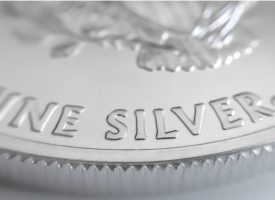With so many investors worried about how quickly the significant moves in the gold, silver and mining share markets have unfolded, here is an early sign that the public is becoming more involved in the gold market. This will only increase over time as the bull markets in gold and silver really begin to assert themselves.
August 18 (King World News) – The piece below was released by Charles Schwab to inform its account holders how to get involved in the gold market and it is extremely well done. It is admirable that they are trying to get their customers to the safety of the gold market and giving such a fantastic and detailed explanation to their people. Nice work Charles Schwab!

A Guide to Investing in Gold
Learn about why gold is considered to be so valuable as well as various vehicles that allow you to hold an interest in gold.
By: Schwab Trading Services
Investors and traders have long held a great fascination with gold. Some of this fascination is no doubt related to the mystique that surrounds the yellow metal. Some of it is also due to the intrinsic value involved in holding a piece of essentially indestructible metal. In any event, due to its unique qualities, gold has long offered investors a one-of-a-kind investment opportunity.
In this guide we will discuss the reasons why this has been, why it remains so, and why gold will remain a unique investment opportunity far into the future. But even more importantly we will also detail a variety of investment vehicles available that can allow you to hold an interest in gold and to participate in bullish and/or bearish price movements in the world’s most renowned precious metal.
The decisions regarding if, when, and how to allocate investment capital to gold are personal ones. The purpose of this guide is not to tell you when or even whether to make such a commitment, nor to tell you which investment vehicle to choose. The goal of this guide is simply to provide you with an understanding of:
1. Reasons why an investment in gold may be right for you.
2. Primary factors that can affect the price of gold.
3. Commonly used investment vehicles for trading gold and their relative advantages and disadvantages.
Why Investors and Traders Buy Gold
Before considering an investment in gold, it is helpful to have a clear understanding of the role that gold may play in your investment portfolio, and the unique opportunities that an investment in gold creates. You may choose to consider an investment in gold or gold-related assets for any or all of the following four reasons:
1. As a Store of Value in the Face of Uncertainty
Throughout the world, many country’s governments create and maintain their own fiat currency. The bills and coins they create are what most people think of when they think of the word “money.” Still, most all of today’s government-issued paper fiat currencies have no tangible value and are backed only by government decree. Gold is not created by governments so its value is not dependent upon governments in order for it to retain a certain level of intrinsic value. A government can go bankrupt and its currency can lose much or all of its value. Gold on the other hand, has always, and will likely continue to retain some value based on the fact that it is an indestructible physical commodity—and is perceived by many to be the most precious metal in the world. The bottom line is that while the price of gold can be volatile and may fluctuate widely, unlike paper assets, gold will likely always retain some value. This has been the case for centuries and currently there is no reason to think this won’t be true long into the future. Because of this, many investors believe in the idea of buying and holding gold as a store of value.
2. As a Hedge Against Inflation
Price inflation involves a persistent and/or substantial rise in the general level of prices for goods and services. Inflation is typically related to an increase in the volume of money and results in the loss of value of currency, or purchasing power.
When price inflation occurs, the price of commodities—i.e., real, tangible assets—tends to rise as well. Due in part to its indestructibility, gold is sometimes thought of as the ultimate store of value. As a result, gold has historically served as a useful hedge against inflation. Since World War II, the five years in which U.S. inflation was at its highest were 1946, 1974, 1975, 1979, and 1980. During those five years, the average real return on the Dow Jones Industrial Average was -12%, compared to +130% for gold.1,2
3. To Diversify an Investment Portfolio
Another reason to consider an investment in gold is simple, good old-fashioned portfolio diversification. While many investors tend to focus on stocks and bonds, the reality is that commodities are a viable asset class and are worthy of consideration as a part of any portfolio. Because gold is considered to be one of the pre-eminent commodities in the world, it serves as a common choice for inclusion in any well-diversified portfolio.
During times of uncertainty, inflation, and/or geopolitical tensions, stocks and bonds can decline in value as fear and uncertainty rises. During these times, exposure to commodities in general—and gold specifically—can serve as a useful hedge, as they may stand to increase in value while other asset classes are losing value.
4. To Attempt to Profit from Price Fluctuations
Gold has a history of registering some very large percentage price movements over time. Some traders may ignore all of the more fundamental reasons for trading gold and simply seek speculative profits. Traders looking for meaningful price movement can often find it in the gold market.
In the 1970’s, gold rallied roughly 490% in just three-and-a-half years before subsequently giving back 54% of that advance over the next two-and-a-half years. Over the course of a full decade, starting in 2001, gold rallied almost 600%. From there, the price declined by more than 40% over a three year period.3
Based on these large and often prolonged price swings, it is not at all surprising that many investors buy (and/or sell short) gold or gold-related assets in an effort to generate speculative profits. Also, as we will discuss shortly, investors can participate in long-, intermediate-, and short-term price movements in the price of gold via a wide variety of investment vehicles.
Factors that Can Influence the Price of Gold
Before considering an investment in gold, it is helpful to become knowledgeable about some of the more prominent factors that can influence the price of gold. As with virtually any asset, there are multiple factors that can exert an influence on the price of gold at any given point in time. As a result, there is no one single factor that you can follow that will divine with certainty which way gold is headed next. Still, by monitoring a variety of influencing factors, you can better make decisions regarding the timing of your gold investments.
Because gold is a physical commodity as well as a form of money, there are some factors that can influence the price of gold directly, while other factors may influence the price of gold inversely. This will make more sense after the following discussion.
Correlated Factors
1. Supply and Demand
Virtually every physical commodity in the world is affected by changes and trends in the supply and demand for that particular commodity. Simple economics teaches us that if there is a surge in demand—and/or a sharp decline in supply—for a given product, then the price of that product will typically rise in price and vice versa.
The supply of gold will fluctuate based on the overall level of gold mining production and also from the amount of gold that is recycled from old jewelry and other sources.
On the demand side of the equation, gold has been a valuable and highly sought-after precious metal for coinage, jewelry, and other uses since the beginning of recorded history. Though the largest demand for gold comes from those who use the metal to create jewelry, gold is also used to manage risk in financial portfolios and to protect the wealth of nations as central banks of various countries may at times acquire gold to support the value of their currency.
These diverse uses for gold mean that different sectors in the gold market may rise in prominence at different points in the global economic cycle. This self-balancing nature of the gold market means that, typically, there is a sustained base level of demand.
2. Inflation
As we mentioned earlier, price inflation—when it occurs—is a powerful reason to consider an investment in gold. During times of inflation, physical, tangible assets tend to rise in price. As gold bullion is often referred to as the “ultimate store of value”, there can be a strong surge of demand for gold during periods of inflation. This phenomenon occurred most notably in the late 1970’s. As the overall rate of inflation rose into double digits, the price of gold bullion soared over 700%.3
Conversely, if inflation peaks and begins to decline sharply, a great deal of gold selling may occur as many investors unwind the positions they bought originally as a hedge against inflation. This aggressive selling and increased supply can serve to drive the price of gold bullion lower.
3. Geopolitics
Any number of unexpected world events can lead to shocks in world economics. Coups, wars, debt crises, political tensions, economic hardships, and so on can all lead to heightened tensions in the political and financial markets. The price of gold is typically, but not reliably, positively correlated with rising geopolitical tensions. Quite often, the reaction in the price of gold to unexpected events is swift and pronounced. It should also be noted that waiting for an unforeseen event to occur and then buying gold often involves getting in “too late”, i.e., after the gold market has reacted to the news. As a result, and as future shocks are inevitable, some investors may feel compelled to hold a portion of their portfolio in gold on a long-term basis as a hedge against any variety of unforeseen events.
Inversely Correlated Factors
While the price of gold may react directly to changes in supply and demand, inflation, and geopolitical events, the price will often move inversely to the action among these three other influencing factors.
1. The U.S. Dollar
Generally speaking, the price of gold tends to move inversely to the value of the United States dollar. In other words, gold tends to decline when the U.S. dollar is strong and gold tends to rise when the U.S. dollar is weak. The inverse nature of the relationship between the U.S. dollar and gold bullion has been quite persistent for several decades. However, it should be noted that this is not an inviolable 1-to-1 inverse relationship, and gold and the dollar can and will both rise or fall in tandem at times.
2. The Stock Market
There is an old investment adage that states “money will flow to where it is treated the best.” To put it another way, various investment vehicles essentially compete with one another to attract investment dollars. The money can be used to buy stocks, bonds, or physical commodities such as gold. If the stock market is performing well and gaining ground consistently, there is an incentive to put money to work there and to eschew other investments such as bonds and gold.
On the other hand, when the stock market is weak, there is an incentive to move away from stocks and to pursue assets that move based on factors not related to the fundamentals that typically move stocks (sales, earnings, dividends, etc.). As the foremost perceived store of value, gold is a natural choice for many investors.
So in broad terms, when the stock market is declining, there is an incentive to invest in gold and vice versa.
3. Interest Rates
Though not as pronounced as the relationship between stocks and gold, the price of gold and the trend of interest rates (i.e., bond yields) have long held a mildly inverse relationship as well. This should not be surprising. As previously mentioned, various investment vehicles compete for investment dollars. As a result, if interest rates are rising and/or are at a high level, this draws investment capital away from gold as investors seek to lock in a given yield level by buying bonds. Likewise, if interest rates are falling, investors may have an incentive to move money into bonds and away from other assets such as gold.
Three Methods for Buying/Trading Gold
Now that we have discussed a variety of factors that may influence the price of gold, it is time to turn our attention to the various investment vehicles you might consider should you choose to participate in the movement of the price of gold. It should be noted that this is not a comprehensive list of all available methods for participating in movements in the price of gold. It does however include three primary types of trading vehicles that can be traded through a Schwab account.
While each of the three instruments that we will discuss is designed to track the price of gold—or a related asset, such as gold mining companies—each instrument also comes with its own unique set of advantages and disadvantages. The following discussion of each of these instruments is intended to help you clearly understand the unique nature of each instrument and the potential risks and rewards associated with each instrument.
1. Exchange-Traded Funds (ETFs)
Prior to 2004, if you wanted to participate in the gold market your primary choices were mostly limited to buying physical gold bullion, trading gold futures contracts, or buying and selling shares of gold mining companies. However, with the advent of gold ETFs (exchange-traded funds), you can now participate in the movements of the price of gold just as you can buy or sell shares of any stock.
There are several ETFs currently available that you can trade through a standard cash or margin account that are designed to track the price of gold bullion. There are several important advantages and disadvantages associated with buying gold ETFs versus other forms of gold investment.
Gold ETF Advantages
1. You can participate in fluctuations in the price of gold just as you buy and sell shares of stock.
2. Unlike futures contracts, ETF shares do not have an expiration date. So you can hold the shares for as long or short of a time as you wish.
3. You do not need to transport, store, and ensure your holdings as you would if you held physical gold yourself.
4. You are not subject to the risks of leverage typically associated with trading gold futures contracts.
Gold ETF Disadvantages
1. In a crisis, you do not personally own physical gold bullion and have no avenue to acquire it. In other words, you cannot contact the ETF’s sponsor and tell them to send you your share of the portfolio in gold bullion.
2. You pay an annual expense fee to hold the ETF, which can serve to reduce returns over time.
Types of Gold ETFs
There are a number of gold ETFs available, each with distinct differences in several factors including what they hold, trading volume, and expense ratios. Here are just a few of the most popular gold ETFs:
• SPDR Gold Trust ETF (Ticker GLD)
Shares of ticker GLD began trading on November 18th, 2004. Ticker GLD attempts to track the London Bullion Market Association (LBMA) Gold Price PM Index divided by 10. So if the benchmark index stands at $1,000 per ounce, then one share of ticker GLD should trade for roughly $100 ($1,000 / 10). In order to purchase 100 shares of GLD at this price you would need $10,000 in cash, or to buy the shares on margin you would need to put up $5,000 in cash and borrow the other $5,000 from your broker.
GLD holds 100% of its portfolio in gold bullion. As of late 2015, GLD was trading roughly 6 million shares per day and charged an annual expense ratio of 0.40%.4, 5
• iShares Gold Trust (Ticker IAU)
Shares of ticker IAU began trading on January 28th, 2005. Similar to GLD, it too tracks the LBMA Gold Price PM Index but divides it by 100, rather than 10.
So if the benchmark index stands at $1,000 per ounce, then one share of ticker IAU should trade for roughly $10 ($1,000 / 100). To purchase 100 shares of IAU at this price you would need $1,000 in cash, or to buy the shares on margin you would need to put up $500 in cash and borrow the other $500 from your broker.
IAU also holds 100% of its portfolio in gold bullion. As of late 2015, IAU was trading roughly 5 million shares per day and charged an annual expense ratio of 0.25%.4, 6
• C. ETFS Physical Swiss Gold Shares (Ticker SGOL)
SGOL is another popular gold ETF with a slightly unique twist. One concern some investors have with gold ETFs is that they don’t feel certain that their physically-backed gold ETF is storing their bullion securely and/or where exactly the vaults that hold the fund’s gold are located. For many gold ETF traders this is not an issue, as they are primarily interested in participating in the price fluctuations. However, for investors who have these concerns, charter ticker SGOL holds all of its gold in secure vaults in Zurich, Switzerland.
Like IAU, SGOL tracks the LBMA Gold Price PM Index divided by 10.
SGOL holds 100% of its portfolio in gold bullion in these vaults in Switzerland. As of late 2015 SGOL was trading roughly 30,000 shares per day and charged an annual expense ratio of 0.39%.4, 7
Assessing Differences in Gold ETFs
• What They Hold and Where
Each of the gold ETFs listed hold 100% of their portfolio in gold bullion. GLD and IAU may hold their bullion in a variety of locations while SGOL holds all of its bullion in Switzerland.
• Trading Volume
For active traders, more trading volume typically—though not always—results in tighter bid/ask spreads and potentially better fills when entering and exiting trades. As of late 2015, GLD was consistently the most heavily traded gold ETF with IAU a fairly close second and SGOL a distant third.
• Expense Ratios
Expense ratios are an important consideration for longer-term investors, more so than for shorter-term traders. A higher annual expense ratio eats up a larger amount of capital than a lower ratio. Because the ETFs we have mentioned all hold essentially the same thing—gold bullion—a lower expense ratio can serve as an advantage over longer periods of time.
As of late 2015, IAU had the lowest expense ratio of 0.25%8, with SGOL second at 0.39%9 and GLD third at 0.40%.5 It should be noted that expense ratios can be raised or lowered over time. As a result, you may wish to verify the current expense ratio for any gold ETF you are considering prior to purchase.
2. Gold Mining Stocks and ETFs
The stock shares of companies that engage in the business of mining gold offer traders and investors another gold-related investment opportunity and trading alternative. Prior to the advent of gold ETFs that actually hold gold bullion in their portfolio, gold mining stocks were the most common choice for traders looking to make a play on the price of gold. Since that time, gold mining stocks have taken on the role of a more specialized—and generally more speculative—form of gold-related investment.
Gold stock prices have showed a historical tendency to be quite volatile. A trader who expects a rise in the price of gold may choose to purchase gold mining shares instead, hoping that based on the volatile nature of gold mining stocks that they will rise at a faster rate than the price of gold itself.
Certainly the price of gold is a key factor in valuing gold mining stock shares. However, while there is inarguably a strong correlation between the trend for the price of gold and the trend for the price of gold mining shares, there are other business-related factors that can cause gold mining shares to outperform or underperform gold bullion itself.
In addition to individual gold mining stocks, investors also have the choice of purchasing gold mining ETFs. These ETFs hold a portfolio of individual mining stocks designed to track a particular gold mining stock index. These gold mining ETFs offer investors and traders the potential to trade a basket of gold mining stocks via a single purchase, rather than having to choose individual issues.
Differences between Physical Gold and Gold Mining Stocks
The difference between physical gold and gold mining shares is pretty simple to spell out. Gold bullion is a piece of metal. A gold mining stock share is a piece of ownership in a company whose primary business is exploring for, mining and/or producing salable gold bullion. While a piece of gold bullion may sit in a vault or be manufactured into jewelry, a gold mining company must pay employees, buy equipment, and perform the actions required to extract gold bullion from the earth and bring it to market for sale.
It should surprise no one to learn that the majority of gold mining stocks trade in a manner that is highly correlated to gold bullion. However, as it is in any line of business, not all gold mining stocks are created equal. Some companies run their business more efficiently than others and some have unique fundamental advantages over other companies in their industry. This is true of the gold mining industry just as it is for any other industry.
Individual Mining Stocks
Some investors will attempt to discern which individual gold mining stocks enjoy the best prospects for price growth and will focus their investment in those issues. The fundamental sales and earnings prospects for individual mining companies can change over time, so if you choose to invest in individual gold mining stocks, you should be prepared to do some homework to help you make decisions regarding which offers the greatest potential. A good place to start might be to consider a handful of gold miners who have been around a long time and typically enjoy greater trading volume.
Gold Miner ETFs
If you are very good at picking individual stocks within an industry group, you may be able to maximize your returns by picking top-performing individual gold mining stocks. However, thanks to the advent of ETFs, it is possible to trade the gold mining industry as an asset class rather than having to pick individual stocks to buy. If you wish to hold a portion of your portfolio in gold mining stocks, there are several gold mining stock ETFs which allow you to buy a basket of gold mining stocks via a single purchase. Several of the more heavily traded gold miner ETFs are discussed below.
• Market Vectors Gold Miners ETF (Ticker GDX)
Ticker GDX is an ETF designed to track the NYSE Arca Gold Miners Index. The ETF holds shares of roughly 40 mining stocks with over half of the portfolio value invested in the Top 10 holdings. The fund is primarily invested in medium- to large-size companies with almost 90% of the portfolio held in non-U.S. companies. As of late 2015, ticker GDX routinely traded over 50 million shares a day and had an annual expense ratio of 0.53%.7
• Market Vectors Junior Gold Miners ETF (Ticker GDXJ)
Ticker GDXJ is an ETF designed to track the Market Vectors Junior Gold Miners Index. As the name implies, ticker GDXJ holds shares of gold mining companies with smaller market capitalizations than those held by ticker GDX. The ETF holds shares of roughly 60 mining stocks with about 40% of the portfolio value invested in the Top 10 holdings. The fund invests roughly 70+% in small- to medium-size companies with Canadian and Australian companies comprising roughly 80% of the portfolio. As of late 2015 the ETF routinely traded over 10 million shares a day and had an annual expense ratio of 0.57%.4,8
Other ETFs that track an index of gold mining stocks include iShares MSCI Global Gold Miners ETF (ticker RING), Gold Miners ETF (ticker SGDM), and Global Gold and Precious Metals Portfolio (ticker PSAU). This list is not comprehensive and investors are encouraged to explore the universe of gold miner ETFs before investing.
3. Gold Futures Contracts
Futures trading is not available directly through Schwab, however, futures trading is available through Schwab’s optionsXpress affiliate. A gold futures contract represents a binding agreement between two parties to trade a specific amount of gold at a specific price on a specific date in the future. In the futures markets, this future date is referred to as the “settlement day.” At the time the agreement is made, the buyer does not immediately pay the agreed upon price and the seller does not deliver any gold. If an actual exchange of cash and gold is to take place between the buyer and seller, it will occur on the settlement day.
Most futures traders use this delay between agreeing to terms and the actual settlement day to speculate that the price of gold will move in their favor prior to settlement day. In the majority of (though not all) cases, the futures trader will exit the position prior to settlement day rather than actually receive or deliver physical gold bullion. By closing the futures position prior to settlement day, the trader can simply settle the gain or loss that has accrued based on the change in the price of gold since the original position was entered.
Futures Contracts Available and Contract Value
Gold futures are primarily traded at three different exchanges: NYSE-Liffe, the Tokyo Commodity Exchange, and the CME Group’s New York Mercantile Exchange, where the most heavily traded gold futures contract is traded under the ticker symbol GC. The primary contract months are February, April, June, August, October, and December.
Each COMEX gold futures contract is for 100 ounces of gold bullion and its price is quoted as dollars per ounce. The minimum “tick size” is $0.10 per ounce and each tick is worth $10 making each $1 in current price for a COMEX gold futures contract worth $100 in terms of contract value. For example, if a given gold futures contract is trading at $1,000 an ounce, then the dollar value for that contract would be 1,000 times $100 per ounce, or $100,000. If the price of the contract were to rise 10 ticks (10 X $0.10) to $1,001.00 per contract, then because each tick is worth $10 in value, the dollar value for that contract would rise from $100,000 to $100,100.
If you buy a gold futures contract at a price of $1,000 per ounce and subsequently sell that contract (rather than holding it until settlement day) at a price of $1,001.00 per ounce, you will earn a profit of $100 (10 ticks X $10 per tick). If you buy a gold futures contract at a price of $1,000 per ounce and subsequently sell that contract at a price of $999.00 per ounce, you will suffer a loss of $100 (-10 ticks X $10 per tick).
It should be noted that if you expect the price of gold bullion to decline instead of rise, you can sell short a gold futures contract just as easily as a trader expecting a rise in the price of gold can buy a gold futures contract. After selling short a gold futures contract, you will attempt to buy back the contract and cover the short position at a lower price than that which you originally sold it short. If you are able to buy back the contract at a lower price than that at which you originally sold short, you will earn a profit. For example, if you sold short a gold futures contract at $1,000 an ounce and later bought it back at $990 an ounce, you would earn a profit of $1,000 ($100 per point X 10.00 point).
Understanding Futures Margin Requirements
One of the things that make futures trading unique is the amount of “leverage” involved. In order to buy or sell short a futures contract, you do not need to put up the full dollar value of the contract at the time a trade is entered. Instead, you only need to hold in your futures trading account the exchange-required “initial margin” amount. While the amount required can vary widely from time to time, initial minimum margin is typically between 2% and 10% of the actual dollar value of the futures contract.
Before presenting an example, it should be noted that the word “margin” has a different meaning in the futures markets than it does in the stock market. In stock trading, trading “on margin” means putting up half of the cost of the stock shares in a stock margin account and borrowing the rest from the stock brokerage firm. In futures trading, a “margin” deposit essentially represents a “good faith deposit” required of a trader in order to enter into a long or short position in a given futures contract.
After the trade is entered, the trader must maintain a minimum account value known as the “maintenance margin” level. If the account value drops below the maintenance margin level, the trader will need to enter money into the account immediately to get back above that level, or the brokerage firm may liquidate the open position.
Initial and maintenance margin requirements can vary over time as exchanges may occasionally raise or lower these requirements in the face of rising and/or declining volatility and rising or falling contract values. To understand the impact of trading futures contract using margin, and to better appreciate the degree of leverage involved in futures trading, let’s consider an example using gold futures.
Gold Futures Example:
• A gold futures contract is trading at a price of $1,100 an ounce. Each $0.10 tick is worth $10 so each $1.00 in price is worth $100. As a result, the contract value is $110,000 (1,100 X $100).
• The margin requirement at the time the trade is entered is $4,000 (but remember that this amount can change over time). In order to buy one gold futures contract, you must have a minimum of $4,000 in your futures trading account.
• To put it another way, you are able to control $100,000 worth of gold by putting up just $4,000, or 4% of the value of the contract. This represents leverage of 25-to-1 ($100,000 / $4,000).
Relative Advantages and Disadvantages of Trading Gold Futures
There are three potential primary advantages associated with using futures contracts to trade gold. The first is that a futures contract is a direct play on the price of gold. Unlike gold mining stocks, which we will discuss later and which trade “based on” fluctuations in the price of gold or some derivative, gold futures will generally rise or fall in line with fluctuations in the price of cash gold bullion. For a trader who believes that the price of gold is about to rise (or fall), a position in a futures contract offers the opportunity to participate directly in the anticipated price movement.
The second potential advantage rises from the amount of leverage involved in trading a futures contract. Let’s go back to our earlier example of putting up $4,000 in margin money to buy a gold futures contract with a contract value of $100,000. If you enter this position and gold rises in price by 4%—from $1,000 to $1,040—then the value of the futures contract will rise from $100,000 to $104,000. This $4,000 increase in value represents a 100% gain on the $4,000 of margin money put up to enter the trade. The bottom line is that a futures trader who successfully times his or her entries and exits has the potential to generate above-average percentage gains.
The third potential advantage stems from the fact that futures markets trade nearly 24 hours per day during the trading week. This gives traders the opportunity to react quickly when opportunities arise in the markets or trade whenever it’s convenient, which occasionally may be after the equity markets have closed.
The primary disadvantage to trading gold futures contracts is that the leverage involved can serve as a double-edged sword. While a well-timed trade can generate a large percentage gain, a losing trade can just as easily generate a large percentage loss. In fact, unlike stock trading—where the most that a trader can lose on a trade is the amount they put into the trade—in futures trading it is possible to lose more than the amount initially committed to enter a given trade.
Going back to our example again, a trader puts up $4,000 in margin money in order to buy a gold futures contract with a contract value of $100,000. At the time the maintenance margin level is $3,200. If the price of gold declines today by 5%, then the value of the futures contract will decline from $100,000 to $95,000. The trader now has an open loss of $5,000 which exceeds the $4,000 in margin he or she put up to enter the position. The broker will issue a “margin call” and require the trader to deposit enough funds in the account to return account equity all the way back up to the initial margin level. The trader in this example will need to immediately wire $5,000 into his or her account or the brokerage firm will close the future position. In any event, the trader will need to deposit $1,000 to cover the loss that was in excess of the initial margin deposit. Alternatively, in some cases if the trader is holding a position of two or more gold futures contracts, it is possible that the position size may be reduced enough (by exiting one or more contracts) that the total amount of margin required decreases back below the amount of equity in the account.
From this discussion it should be clear that you should approach gold futures trading as a potential “high risk/high reward” endeavor.
Conclusion
There are many potential factors involved in deciding if, when, and how to invest in gold. This guide is not comprehensive in terms of imparting the information you will need to decide if and when to invest in gold. It is also designed to help you to delineate between the relative advantages and disadvantages associated with some of the various gold-related investment vehicles available to you, including futures contracts, ETF shares, or stock shares on any of these.
In essence this guide is intended to help you formulate your own answers to each of the relevant questions associated with an investment in gold. Among the key questions that you may wish to ask and answer before committing actual investment capital are:
• Does an investment in gold appeal to you? And if so, can you put into your own words why it appeals to you?
• What are the key factors that can influence the price of gold and how well do you understand them?
• Are you interested in buying and holding gold? Or are you more interested in trading on a more active basis?
• Do you have a preference in terms of the investment vehicle(s) that you will most likely use to invest in gold?
• Do you wish to hold an interest related directly to physical gold bullion (gold futures, gold ETFs) or some related investment such as gold mining stocks or gold mining ETFs?
We encourage you to think through and generate answers for each of the questions posed above. By going through this process you can gain a greater understanding not only of the key factors involved in gold investing, but a greater insight into your own motivations, perspectives, and investment preferences and objectives.
***KWN has now released the extraordinary audio interview with Stephen Leeb discussing the gold and silver markets, what major surprises investors should expect and much more and you can listen to it by CLICKING HERE OR ON THE IMAGE BELOW.
***ALSO JUST RELEASED: Is This Shocker About To Send The Price Of Gold & Silver Soaring? CLICK HERE.
***KWN has also now released the incredible audio interview with Rick Rule, where he discusses what investors should be doing with their money and their accounts right now, the gold and silver markets and much more CLICK HERE OR ON THE IMAGE BELOW.
© 2016 by King World News®. All Rights Reserved. This material may not be published, broadcast, rewritten, or redistributed. However, linking directly to the articles is permitted and encouraged.









